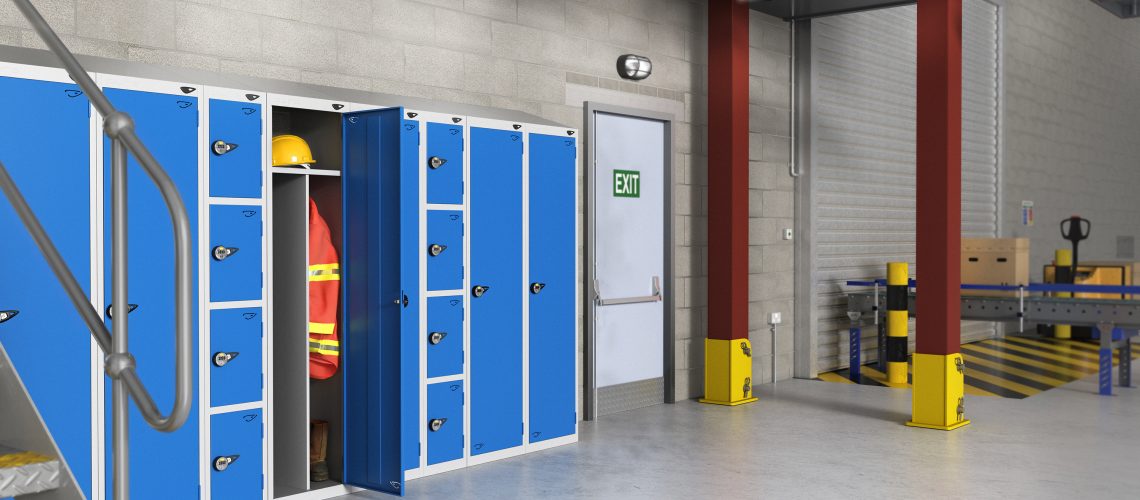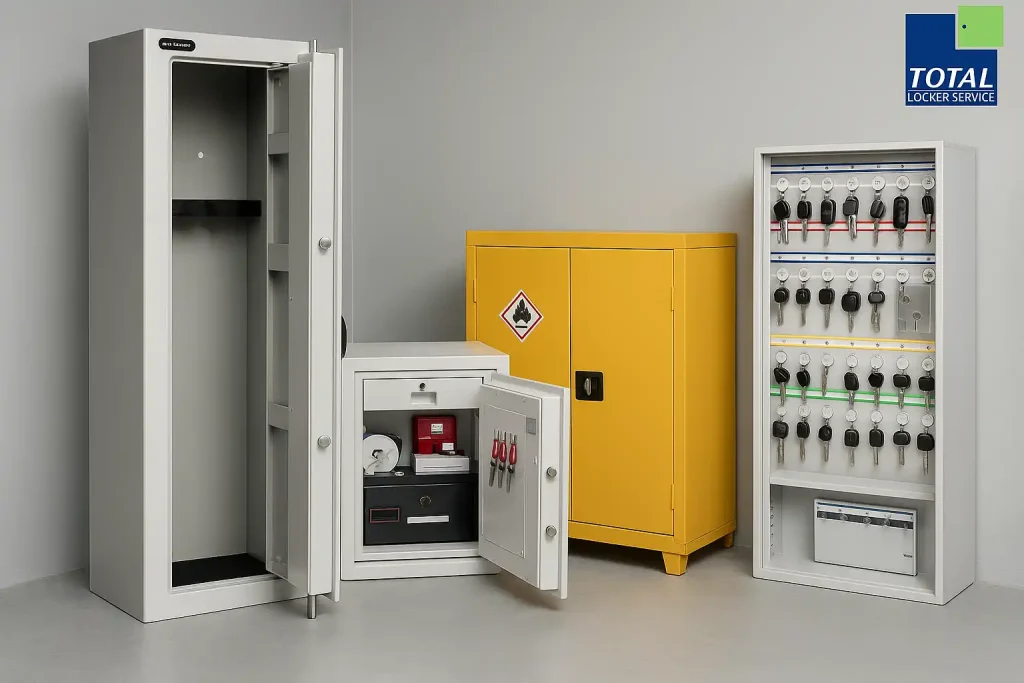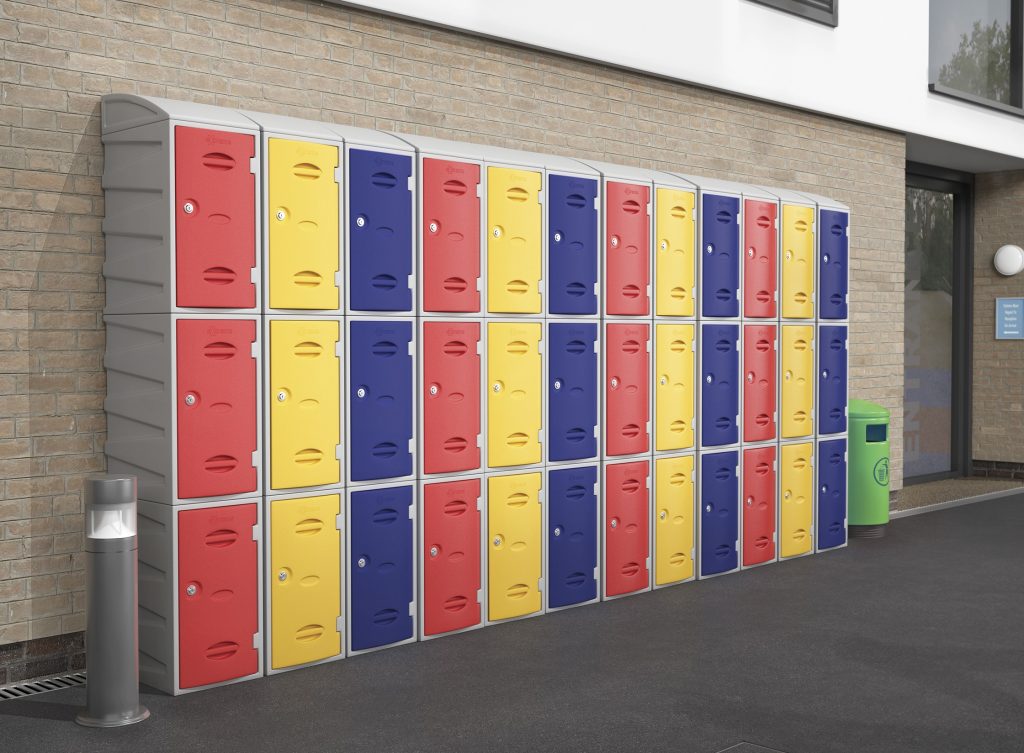Beyond the Unit: The Full Lifecycle Cost, Sustainability & Future-Proofing of Locker Systems in UK Facilities
November 7, 2025

Today’s facility managers face mounting pressure to demonstrate value whilst maintaining sustainable operations. Consequently, a comprehensive lifecycle cost analysis becomes essential. Furthermore, this approach reveals opportunities for optimisation that traditional budgeting methods simply miss. Therefore, let’s explore the complete financial picture of locker system ownership in UK facilities.
Understanding True Lifecycle Costs
The concept of lifecycle costing encompasses every expense from initial specification through to eventual decommissioning. Initially, many organisations focus solely on capital expenditure. Nevertheless, operational costs frequently exceed the original purchase price over a system’s lifespan. Additionally, these ongoing expenses accumulate quietly, often escaping rigorous scrutiny.

Research from the British Institute of Facilities Management consistently demonstrates this pattern. Specifically, maintenance and operational costs typically represent 60-80% of total ownership expenses. Meanwhile, the initial purchase accounts for merely 20-40% of lifetime spending. Thus, decisions based purely on upfront pricing often prove economically unsound.
Locker system lifecycle costs UK Breaking Down the Cost Components
Several distinct cost categories demand consideration. First, acquisition costs include the equipment itself plus delivery and installation expenses. Subsequently, operational costs emerge through energy consumption, particularly for electronic locking systems. Then, maintenance expenses arise from repairs, parts replacement, and routine servicing. Finally, end-of-life costs involve removal, disposal, and environmental compliance.
Each component varies significantly based on system specification and quality. For instance, premium materials command higher initial investment. However, they simultaneously reduce maintenance frequency and extend operational lifespan. Similarly, advanced locking mechanisms increase upfront costs whilst delivering superior security and reliability. Therefore, balancing these factors requires sophisticated analysis.
Installation Considerations and Hidden Costs
Installation represents a critical phase that many organisations underestimate. Initially, site preparation may require structural modifications or electrical upgrades. Additionally, installation complexity varies dramatically between mechanical and electronic systems. Furthermore, timing constraints can necessitate premium labour rates or overtime charges.
Professional installation ensures optimal performance and longevity. Conversely, inadequate installation creates ongoing problems that multiply costs exponentially. For example, poorly aligned doors accelerate wear on hinges and locking mechanisms. Meanwhile, incorrect mounting compromises structural integrity and user safety. Consequently, investing in experienced installers delivers measurable returns.
UK building regulations add another layer of complexity. Specifically, Approved Document M mandates accessibility requirements for certain installations. Moreover, fire safety regulations influence material selection and placement decisions. Therefore, compliance expertise becomes essential during the installation phase.
Electrical Infrastructure Requirements
Electronic locking systems demand robust electrical infrastructure. Initially, power supply installation requires qualified electricians and appropriate certification. Subsequently, ongoing electricity costs accumulate throughout the system’s operational life. Additionally, backup power systems may prove necessary for critical applications.
Modern systems increasingly incorporate energy-efficient technologies. Notably, low-power electronic locks dramatically reduce consumption compared to earlier generations. Furthermore, intelligent power management extends battery life in wireless systems. Thus, specifying energy-efficient components delivers both environmental and financial benefits.
Locker system lifecycle costs UK Maintenance Planning and Preventive Strategies
Effective maintenance programmes protect your investment and maximise system longevity. Primarily, preventive maintenance identifies potential issues before they escalate into costly failures. Moreover, scheduled servicing maintains optimal performance and user satisfaction. Additionally, comprehensive maintenance contracts provide budget certainty and prioritised support.

Different locker types demand varying maintenance approaches. Mechanical systems require periodic lubrication, hinge adjustment, and lock servicing. Meanwhile, electronic systems need software updates, battery replacement, and sensor calibration. Furthermore, laminate and powder-coated surfaces benefit from specific cleaning protocols. Therefore, maintenance strategies must align with system specifications.
Creating Maintenance Schedules
Structured maintenance schedules optimise both performance and costs. Initially, daily inspections identify obvious damage or malfunction. Subsequently, weekly checks verify door operation and locking mechanism function. Then, monthly maintenance addresses minor adjustments and cleaning requirements. Finally, annual servicing performs comprehensive system evaluation and component replacement.
Documentation plays a crucial role in effective maintenance management. Specifically, detailed service records track system performance over time. Additionally, these records identify recurring issues and inform replacement decisions. Furthermore, comprehensive documentation supports warranty claims and demonstrates regulatory compliance. Thus, robust record-keeping delivers multiple strategic advantages.
Material Selection and Durability Impact
Material choices profoundly influence both initial costs and long-term performance. Primarily, substrate materials determine structural integrity and lifespan expectations. Moreover, surface finishes affect appearance retention and cleaning requirements. Additionally, locking hardware quality directly impacts security and maintenance frequency.
Steel construction offers exceptional durability and security. Specifically, fully welded steel bodies resist forced entry and withstand heavy use. Furthermore, powder-coated steel surfaces provide superior scratch resistance and colour retention. However, steel systems command premium pricing compared to alternatives. Nevertheless, their extended lifespan often justifies the additional investment.
Composite materials present interesting alternatives for specific applications. Notably, high-density polyethylene (HDPE) offers excellent moisture resistance. Additionally, laminate surfaces provide diverse aesthetic options and reasonable durability. However, these materials typically suit lighter-duty applications. Therefore, matching materials to usage intensity proves essential.
Environmental Considerations in Material Choice
Sustainability concerns increasingly influence material selection decisions. Initially, recycled content reduces environmental impact without compromising performance. Subsequently, recyclability at end-of-life facilitates responsible disposal. Furthermore, low-VOC finishes improve indoor air quality and occupant wellbeing. Thus, environmental considerations align with both regulatory requirements and corporate responsibility.
The BREEAM certification system rewards sustainable material choices. Specifically, points accrue for recycled content, responsible sourcing, and lifecycle impacts. Moreover, these certifications enhance property values and tenant satisfaction. Therefore, specifying sustainable materials delivers multiple stakeholder benefits.
Locker system lifecycle costs UK Energy Efficiency and Operational Costs
Electronic locking systems introduce ongoing energy costs that accumulate significantly over time. Initially, power consumption appears negligible on a per-unit basis. However, large installations quickly generate substantial electricity expenses. Moreover, rising energy prices amplify these costs progressively. Consequently, energy efficiency specifications demand careful attention.

Modern technologies dramatically reduce energy requirements. Notably, LED indicators consume minimal power compared to traditional lighting. Additionally, sleep modes activate during periods of inactivity. Furthermore, battery-powered wireless locks eliminate hardwired electrical infrastructure entirely. Thus, technological advances continuously improve energy performance.
Smart Technology Integration
Intelligent locker systems offer sophisticated energy management capabilities. Primarily, occupancy sensors detect usage patterns and optimise power consumption accordingly. Subsequently, centralised management systems monitor performance and identify inefficiencies. Additionally, predictive algorithms adjust operations based on historical data. Therefore, smart systems deliver measurable energy savings.
Integration with building management systems amplifies these benefits. Specifically, coordinated control optimises overall facility energy consumption. Moreover, unified monitoring reduces administrative overhead and improves response times. Furthermore, comprehensive data analytics inform strategic planning and investment decisions. Thus, system integration creates compounding efficiency gains.
Security Features and Risk Management
Security capabilities significantly impact both immediate costs and long-term value. Initially, advanced locking mechanisms command higher purchase prices. However, they simultaneously reduce theft, vandalism, and associated losses. Moreover, enhanced security improves user confidence and satisfaction. Additionally, robust security features may reduce insurance premiums.
Different environments demand varying security levels. Educational facilities require reliable access control and usage monitoring. Healthcare settings need secure medication and equipment storage. Meanwhile, leisure centres prioritise quick access and high throughput. Therefore, security specifications must align with operational requirements and risk profiles.
Audit trails provide valuable accountability and incident investigation capabilities. Specifically, electronic systems log every access event with timestamps and user identification. Subsequently, this data supports security reviews and operational analysis. Furthermore, comprehensive logging demonstrates compliance with data protection and security regulations. Thus, audit capabilities deliver both security and administrative benefits.
Locker system lifecycle costs UK Flexibility and Future-Proofing Strategies
Adaptability ensures your locker investment remains relevant despite changing requirements. Initially, modular designs accommodate easy reconfiguration and expansion. Subsequently, technology upgrades extend system capabilities without complete replacement. Moreover, universal mounting standards facilitate component swapping and updates. Therefore, flexible systems protect against premature obsolescence.
Technology evolves rapidly, particularly in access control and management systems. Consequently, future-proof specifications anticipate emerging standards and capabilities. For example, contactless access technologies continue advancing and gaining adoption. Similarly, mobile device integration increasingly drives user expectations. Thus, specifying upgrade pathways preserves long-term value.
Scalability Considerations
Organisational growth frequently necessitates locker capacity expansion. Ideally, systems accommodate incremental additions without disrupting existing installations. Additionally, expansion maintains consistent appearance and functionality across old and new units. Furthermore, scalable management software supports growing user populations efficiently. Therefore, scalability planning prevents costly future complications.
Standardisation across multiple sites delivers substantial advantages. Primarily, bulk purchasing power reduces unit costs significantly. Subsequently, maintenance becomes more efficient through shared expertise and inventory. Moreover, users experience consistency when moving between locations. Thus, enterprise-wide standardisation creates economies of scale.
Sustainability and Environmental Responsibility
Environmental considerations increasingly influence purchasing decisions across UK facilities. Initially, sustainable specifications align with corporate responsibility commitments. Subsequently, environmental performance affects stakeholder perceptions and brand reputation. Moreover, regulatory requirements continue tightening around environmental impacts. Therefore, sustainability integration becomes strategically essential.

Lifecycle environmental impact extends beyond material sourcing. Specifically, manufacturing processes affect carbon footprints and resource consumption. Additionally, transportation distances influence overall environmental costs. Furthermore, end-of-life recyclability determines waste generation and disposal impacts. Thus, comprehensive environmental assessment considers multiple factors.
Circular Economy Principles
Circular economy thinking transforms traditional disposal approaches. Initially, refurbishment extends product life and delays replacement requirements. Subsequently, component harvesting recovers valuable materials and reduces waste. Moreover, manufacturer take-back programmes ensure responsible recycling. Therefore, circular approaches minimise environmental impact whilst reducing costs.
The UK government actively promotes circular economy adoption. Specifically, the Resources and Waste Strategy establishes ambitious targets. Additionally, Extended Producer Responsibility regulations increase manufacturer accountability. Furthermore, tax incentives reward sustainable practices. Thus, circular economy alignment delivers both environmental and financial benefits.
Locker system lifecycle costs UK User Experience and Operational Efficiency
User satisfaction directly impacts operational efficiency and system value. Initially, intuitive operation reduces support requests and staff intervention. Subsequently, reliable performance maintains user confidence and minimises complaints. Moreover, accessibility features ensure inclusive access for all users. Therefore, user-centric design delivers measurable operational benefits.
Throughput capacity affects both user experience and space efficiency. Specifically, fast access reduces queuing and congestion during peak periods. Additionally, appropriate locker sizing accommodates typical storage requirements without waste. Furthermore, clear numbering and wayfinding systems improve navigation efficiency. Thus, thoughtful design optimises operational flow.
Accessibility and Inclusive Design
Legal requirements mandate accessible design for public facilities. Specifically, the Equality Act 2010 establishes clear obligations. Additionally, accessible design benefits all users, not just those with disabilities. Moreover, inclusive facilities enhance reputation and demonstrate social responsibility. Therefore, accessibility integration creates universal value.
Accessible features include appropriate mounting heights and reachable controls. Furthermore, visual and tactile indicators assist users with various impairments. Additionally, adequate clearance accommodates wheelchair users and mobility aids. Thus, comprehensive accessibility planning ensures regulatory compliance and user satisfaction.
Locker system lifecycle costs UK Technology Integration and Management Systems
Sophisticated management software transforms locker operations and administration. Initially, centralised control simplifies configuration and monitoring across multiple locations. Subsequently, real-time reporting provides visibility into usage patterns and system performance. Moreover, automated alerts notify staff of maintenance requirements and security events. Therefore, management technology dramatically improves operational efficiency.
Cloud-based platforms offer particular advantages for distributed operations. Specifically, remote access eliminates site visits for routine administrative tasks. Additionally, automatic updates ensure systems remain current without manual intervention. Furthermore, scalable cloud infrastructure accommodates growth without hardware investment. Thus, cloud technology delivers flexibility and cost-effectiveness.
Data Analytics and Performance Optimisation
Comprehensive data collection enables evidence-based decision-making. Primarily, usage analytics reveal peak demand periods and capacity utilisation. Subsequently, this intelligence informs expansion planning and resource allocation. Moreover, maintenance data identifies problematic units and recurring issues. Therefore, analytics capabilities transform locker systems into strategic assets.
Predictive maintenance algorithms anticipate component failures before they occur. Consequently, planned interventions prevent disruptive breakdowns and user dissatisfaction. Additionally, optimised maintenance scheduling reduces costs through efficient resource deployment. Furthermore, extended component life results from timely preventive action. Thus, predictive approaches deliver substantial operational advantages.
Replacement Planning and End-of-Life Considerations
Even superior systems eventually require replacement. Initially, depreciation schedules establish expected service life and replacement timing. Subsequently, condition assessments determine whether refurbishment or replacement proves more economical. Moreover, technology obsolescence may necessitate earlier replacement than physical condition alone suggests. Therefore, proactive replacement planning prevents crisis situations.
Disposal costs and environmental obligations demand careful consideration. Specifically, waste carrier licensing and documentation requirements apply to commercial waste. Additionally, hazardous materials require specialist handling and disposal. Furthermore, recycling obligations continue expanding under UK environmental regulations. Thus, end-of-life planning must address both financial and regulatory aspects.
Residual Value and Asset Recovery
Quality systems retain significant value even after primary service concludes. Initially, refurbishment transforms used equipment into cost-effective solutions for less demanding applications. Subsequently, component harvesting recovers valuable materials and hardware. Moreover, responsible recycling minimises disposal costs whilst supporting sustainability objectives. Therefore, residual value considerations affect total lifecycle economics.
Secondary markets exist for quality used locker systems. Specifically, educational institutions and community organisations often welcome affordable refurbished equipment. Additionally, export opportunities serve international markets with different budget constraints. Furthermore, manufacturer buy-back programmes provide convenient disposal alternatives. Thus, multiple pathways exist for value recovery.
Making Informed Investment Decisions
Comprehensive lifecycle analysis empowers informed decision-making that balances immediate costs against long-term value. Initially, detailed specifications clarify requirements and prevent over-specification or inadequate capability. Subsequently, total cost of ownership calculations compare alternatives on equal footing. Moreover, risk assessment identifies potential issues and mitigation strategies. Therefore, thorough analysis delivers optimal outcomes.
Stakeholder engagement ensures specifications address all relevant requirements. Specifically, facility managers contribute operational insights and maintenance perspectives. Additionally, financial teams evaluate budget impacts and funding options. Furthermore, end users provide valuable feedback on functional requirements. Thus, collaborative specification development creates better solutions.
Building Business Cases
Strong business cases secure necessary approvals and funding. Primarily, quantified benefits demonstrate return on investment through reduced maintenance costs. Subsequently, improved security and user satisfaction deliver qualitative advantages. Moreover, sustainability credentials support corporate responsibility objectives. Therefore, comprehensive business cases address multiple decision criteria.
Comparison scenarios illustrate trade-offs between different approaches. Specifically, low-cost options reveal hidden expenses through shorter lifespans and higher maintenance. Meanwhile, premium solutions demonstrate long-term savings despite higher initial investment. Additionally, sensitivity analysis explores how changing assumptions affect outcomes. Thus, thorough analysis supports confident decision-making.
Conclusion: Strategic Value Through Lifecycle Thinking
Moving beyond narrow focus on purchase price unlocks substantial strategic value. Specifically, lifecycle thinking reveals true costs and opportunities for optimisation. Moreover, sustainable approaches align operational decisions with environmental responsibilities. Furthermore, future-proofing strategies protect investments against premature obsolescence. Therefore, comprehensive lifecycle management delivers superior outcomes.
UK facilities face evolving challenges including sustainability mandates, technological change, and budget constraints. Consequently, sophisticated approaches to locker system procurement become increasingly essential. Additionally, regulatory requirements continue expanding, demanding greater attention to compliance. Thus, professional expertise and thorough analysis prove invaluable.
Investment in quality systems, proper installation, and proactive maintenance generates measurable returns. Initially, reliable performance reduces operational disruption and support costs. Subsequently, extended service life defers capital replacement expenses. Moreover, satisfied users and demonstrated sustainability credentials enhance organisational reputation. Therefore, lifecycle thinking transforms locker systems from simple storage into strategic assets.
Ultimately, successful locker system management requires balancing multiple competing priorities. Technical performance, financial constraints, environmental responsibilities, and user requirements all demand consideration. However, comprehensive lifecycle analysis provides the framework for navigating these complexities. Thus, embracing lifecycle thinking positions UK facilities for long-term success whilst delivering immediate operational benefits.
Additional Resources
- British Institute of Facilities Management – Professional guidance and industry standards
- BREEAM – Building sustainability assessment and certification
- UK Building Regulations – Compliance requirements and guidance
- Equality Act 2010 – Accessibility obligations
Discover more from Blog Total Locker Service
Subscribe to get the latest posts sent to your email.